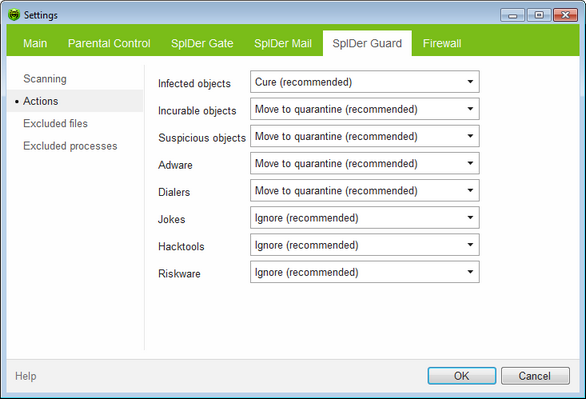On this page, you can configure reactions of SpIDer Guard to detection of infected or suspicious files and malware.
For different types of compromised objects, actions are assigned separately from the respective drop-down lists:
•Objects infected with a known and (supposedly) curable virus
•Incurable objects that are infected with an incurable virus
•Supposedly infected (suspicious) objects
•Objects that pose potential threat (riskware)
Reaction of SpIDer Guard to detection of various malicious software is also set separately. Set of actions available for selection depend on the type of the virus event.

For details on a certain option, click the corresponding item in the picture.
To get information on options available on other pages, click the corresponding item in the picture.
Element |
Description |
|---|---|
Infected objects |
Click to select reaction to detection of objects infected with known viruses (by default, the most effective action is set). |
Incurable objects |
Click to select a reaction to detection of objects infected with incurable viruses (by default, the most effective action is set). |
Suspicious objects |
Click to select reaction to detection of objects infected with supposedly unknown viruses (by default, the most effective action is set). |
Adware |
Click to select reaction to detection of adware (by default, the most effective action is set). |
Dialers |
Click to select reaction to detection of dialers redirecting modem calls to predefined paid numbers or paid resources (by default, the most effective action is set). |
Jokes |
Click to select a reaction to detection of joke programs (by default, the most effective action is set). |
Hacktools |
Click to select a reaction to detection of hacktools (by default, the most effective action is set). |
Riskware |
Click to select reaction to detection of riskware (by default, the most effective action is set). |
By default, SpIDer Guard attempts to cure the infected and supposedly curable files, moves other most dangerous objects to Quarantine, and ignores minor threats such as jokes, hacktools, and riskware.The SpIDer Guard reactions are similar to those of Dr.Web Scanner. ![]() Details
Details
You can select one of the following actions for detected virus threats:
|
After performing reaction you configured, SpIDer Guard can display a notification above the SpIDer Agent icon in the notification area. If necessary, you can configure desktop and email notifications.